Lord & Thomas
Click for PDF version of Albert Lasker -- Lord & Thomas
-- Biography
Click for Albert Lasker - Wikipedia page
Introduction
Albert Lasker
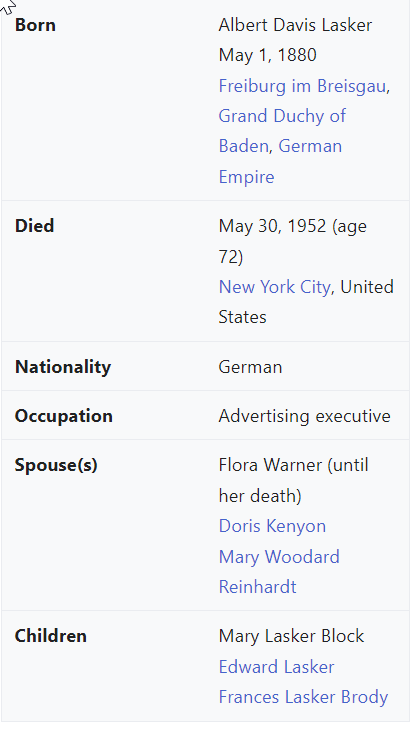 Albert Lasker Life Stats -- Lord & Thomas
Albert Lasker Life Stats -- Lord & Thomas
Albert Lasker can justifiably be called the founder of the modern advertising industry. Albert, the son of a wealthy Galveston, Texas banker, Morris Lasker, became interested in journalism in his early youth. Upon graduation from high school, his first job was with the Galveston Morning News. Disapproving of his son's journalism career, Morris Lasker managed to persuade his son to try an advertising position with the Lord and Thomas agency in Chicago, Illinois. Albert Lasker reluctantly accepted the position with Lord and Thomas, fully intending to only stay a few weeks to satisfy his father. Surprisingly, Albert Lasker was with Lord and Thomas for forty-four years.
 Lord and Thomas Picture
Lord and Thomas Picture
A. The Early Years
 Picture of Lasker (young)
Picture of Lasker (young)
Albert Lasker began his job at Lord and Thomas as an office clerk. After a year, Lasker asked for and was granted a chance to try his luck as a salesman, soliciting accounts in Indiana, Ohio, and Michigan. He was an immediate success. Before the next year was over, Lasker made another daring move. He asked Mr. Thomas to put him in charge of a few accounts that were not making any money so he could practice copy writing. Within a year, he achieved a dramatic success with a hearing aid company. Both Mr. Lord and Mr. Thomas were impressed with Lasker's ingenuity, which in turn caused a fond rapport to develop among the three men. In 1903, when Mr. Lord retired, Lasker purchased his share of the business, thus becoming a partner in Lord and Thomas.
B. Search for Principles of Advertising
Through his early experiences at Lord and Thomas, Lasker discovered the power of advertising and became consumed with the quest to uncover the underlying principles of advertising. He found his answer in 1904 when John E. Kennedy, a former member of the Canadian Mounted Police who was working as a copy writer for Dr. Shoop's Restorative, offered this explanation. -- "Advertising is Salesmanship in Print ('and on the air')".
Kennedy went on to explain that advertising should give the potential reader the reasons why. In essence, advertising should explain why the product being advertised was a better buy than competing products or alternative uses of the consumer's limited budget.
Albert Lasker saw merit in Kennedy's views and explanation of the principles of advertising. He hired Kennedy to work with him at Lord and Thomas. Kennedy stressed hat the way the ad copy was written was crucial to advertising. Lasker began to perceive the need for a copy writing department. He hired several young newspapermen and trained them according to Kennedy's advertising prescription. Thus Lasker created the first systematically trained copy writing staff in America. Kennedy soon left Lord and Thomas to establish his own business but not before Lasker was able to obtain the knowledge and understanding of advertising he needed.
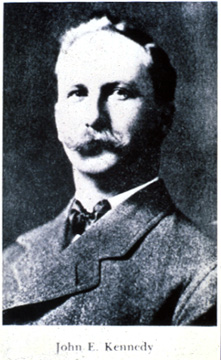 Picture of John E. Kennedy
Picture of John E. Kennedy
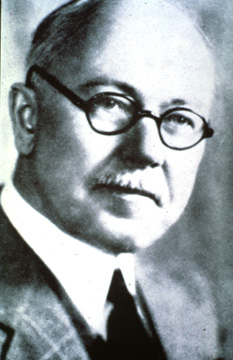 Picture of John E. Kennedy
Picture of John E. Kennedy
With the new emphasis on copy writing, Lasker started Lord and Thomas on the road to becoming the industry leader. In 1908, Lasker hired Claude C. Hopkins, one of the most gifted copy writers of all time. Hopkins shared Lasker's views of what advertising should be. He was quick and effective. Hopkins was able to develop an effective advertsing campaign within 24 hours of visiting a client. With Hopkins aboard, Lord and Thomas would soon become the largest advertising agency in the world.
Some of the most memorable accounts of these early years were: The California Fruit Growers Exchange which later became the Sunkist Growers Inc., and Van Camp's canned pork and beans.
C. Ventures Outside of Lord and Thomas
Leaving the active management of Lord and Thomas to Claude Hopkins, Albert Lasker engaged in politics and briefly baseball between 1918 and 1923. In 1918 Lasker went to New York to direct the publicity program for the Republican National Committee during the congressional campaign. In 1920 he led the unsuccessful drive to make Hiram Johnson the Republican presidential candidate. He then took charge of the publicity for Harding's successful 1920 presidential race. In the process he introduced "modern" advertising techniques to politics. Upon Harding's inauguration, Harding appointed Lasker chairman of the U.S. Shipping Board, where he served for two years.
 Picture of Rebublican National Convention
Picture of Rebublican National Convention
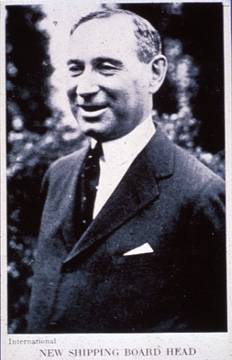 Picture of Lasker as Chairman of Shipping Board
Picture of Lasker as Chairman of Shipping Board
In 1916, Lasker purchased a large block of stock in the Chicago Cubs baseball organization. He soon became the controlling stockholder. In 1919 amidst claims that gamblers had bribed ball players to throw the World Series, Lasker took it upon himself to do something to restore the game to it's former, honorable place. He fought long and hard for an outside, unbiased authority to run the game. And so it was that Judge Kenesaw Mountain Landis became the first baseball commissioner.
During this time a good friend of Albert Lasker's became a stockholder of the Chicago Cubs organization, William Wrigley, a Chicago chewing gum manufacturer. In 1925, Lasker sold his interest in the Cubs to Wrigley. Lasker is largely responsible for the decision to change the name of the playing field from Cubs Park to Wrigley Field.
D. The Second Advertising Career
While Lasker was away, Lord and Thomas slipped from its position as the largest firm in the advertising business. Returning in September of 1923, Lasker set out to regain the industry leadership position. Some of the important accounts of this time were Kimberly Clark, Pepsodent toothpaste, and American Tobacco Company's Lucky Strike cigarettes.
 Picture of Bob Hope
Picture of Bob Hope
In 1926, Lasker entered a new advertising medium - radio. He introduced his "Salesmanship in print" formula to radio and the radio commercial as it is known today was born. Lasker had the ability to capitalize on emerging opportunities. The Amos and Andy show was created by Lord and Thomas as a medium to advertise Pepsodent. Later a struggling young comedian named Bob Hope was given a chance to make a success of a radio show for Pepsodent. Lord and Thomas were the first to broadcast the Metropolitan Opera, "authentic" police and FBI dramas and to chain sponsor Football games.
For a brief time in the 1930's, Lord and Thomas regained its position as the biggest advertising agency in the world.
E. Years of Discontent
In the mid 1930's, Albert Lasker began to lose interest in business affairs. One reason was undoubtedly the successful achievement of his goal of industry leadership. More importantly was the death of his wife, Flora, in December of 1936. After 33 years of marriage, her death left him discontented and caused him to seek new friends, activities, and distractions. Lasker became disenchanted with the advertising business stating the pioneering had disappeared. As the use of advertising grew, major clients began to question and evaluate the advertising campaigns developed by Lord and Thomas. This angered Lasker, causing him to voluntarily give up major accounts with Quaker Oats, RCA and General Electric.
Lasker retired as president in 1938 from Lord and Thomas after his son, Edward, failed to embark on an advertising career. He retained ownership, but Don Francisco became the active manager of Lord and Thomas. In 1942, Albert Lasker decided to leave Lord and Thomas. He decided to liquidate the firm so that the name Lord and Thomas would cease to be used. At this same time he was instrumental in creating a new firm to carry on the work of the existing clients. The new firm was named " Foote, Cone and Belding" and its owner-managers were Lasker's three senior executives at the time - Emerson Foote in New York, Fairfax Cone in Chicago and Don Belding in California. Lasker solicited all of his clients to continue with the new company. All but one client stayed with Foote, Cone and Belding.
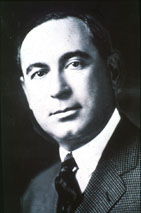 Picture of Albert Lasker
Picture of Albert Lasker
F. The Last Decade
 Picture of Medical Scene
Picture of Medical Scene
Having retired from the business in 1938, Albert Lasker entered into a new life of public affairs and philanthropy. He met Mary Woodard Reinhardt, a New York industrial designer in 1939. They were married in 1940 in New York. His financial contributions and active promotional activities were responsible for major expansions in the nation's medical research activities. He and Mary established the Albert and Mary Lasker Foundation to support medical research. In 1944, he spearheaded a fund raising drive that nearly doubled the amount of money spent on cancer research in the United States. He pursued the idea of getting the federal government more involved in medical research. Through Lasker's efforts the National Institutes of Health was established over the period of 1946- 1950. During this period he became ill and on May 30, 1952 he died at the age of 73.
Conclusion
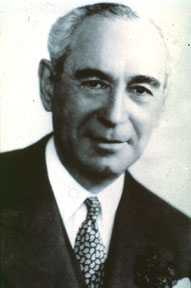 Picture of Albert Lasker
Picture of Albert Lasker
Albert Lasker's ingenuity and unique ability to explain the product being advertised using the philosophy of "Advertising is Salesmanship in Print" have earned him the title of Founder of Modern Advertising by his peers. His focus on the ad copy and establishment of the copy write department were crucial to the advertising industry's evolution. Lasker's creative use of coupons, radio, and potential to see alternative uses for products were keys to his success and the success of Lord and Thomas.
Copyright © 1995 American National Business Hall of Fame. All Rights Reserved.
Copyright 2001 American National Business Hall of Fame. All Rights Reserved.
ANBHF Laureates
Our laureates and fellows exemplify the American tradition of business leadership. The ANBHF has published the biographies of our laureates and fellows.
Some are currently available online and more are added each month.
Back to Top
American National Business Hall of Fame - Contact
c/o Western Illinois University Libraries WIU Libraries
Macomb, IL 61455
(309)298-2705












